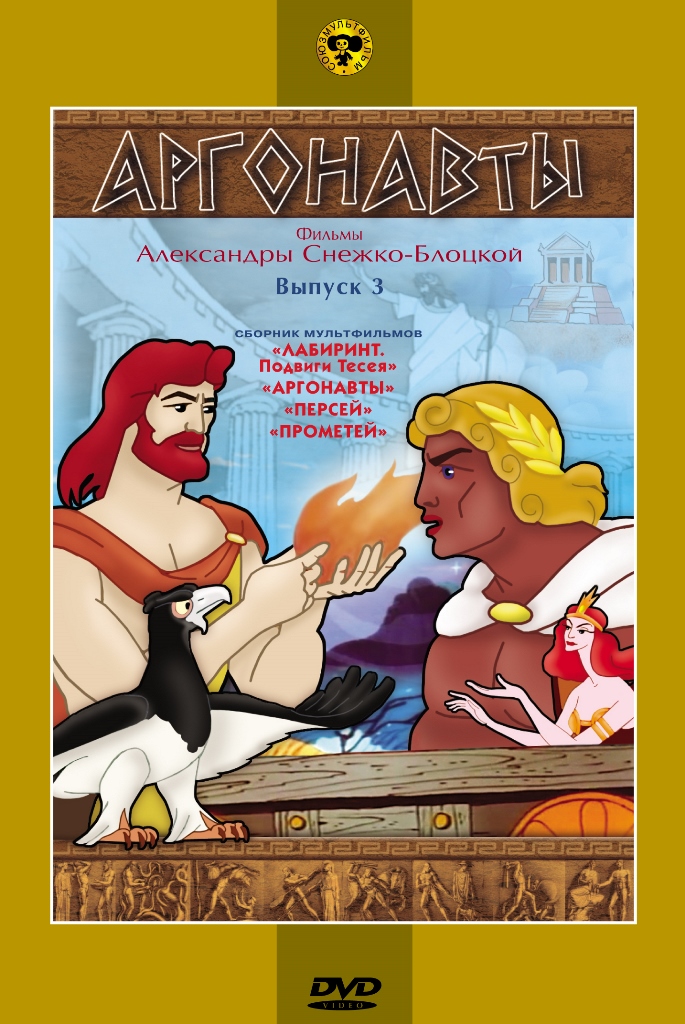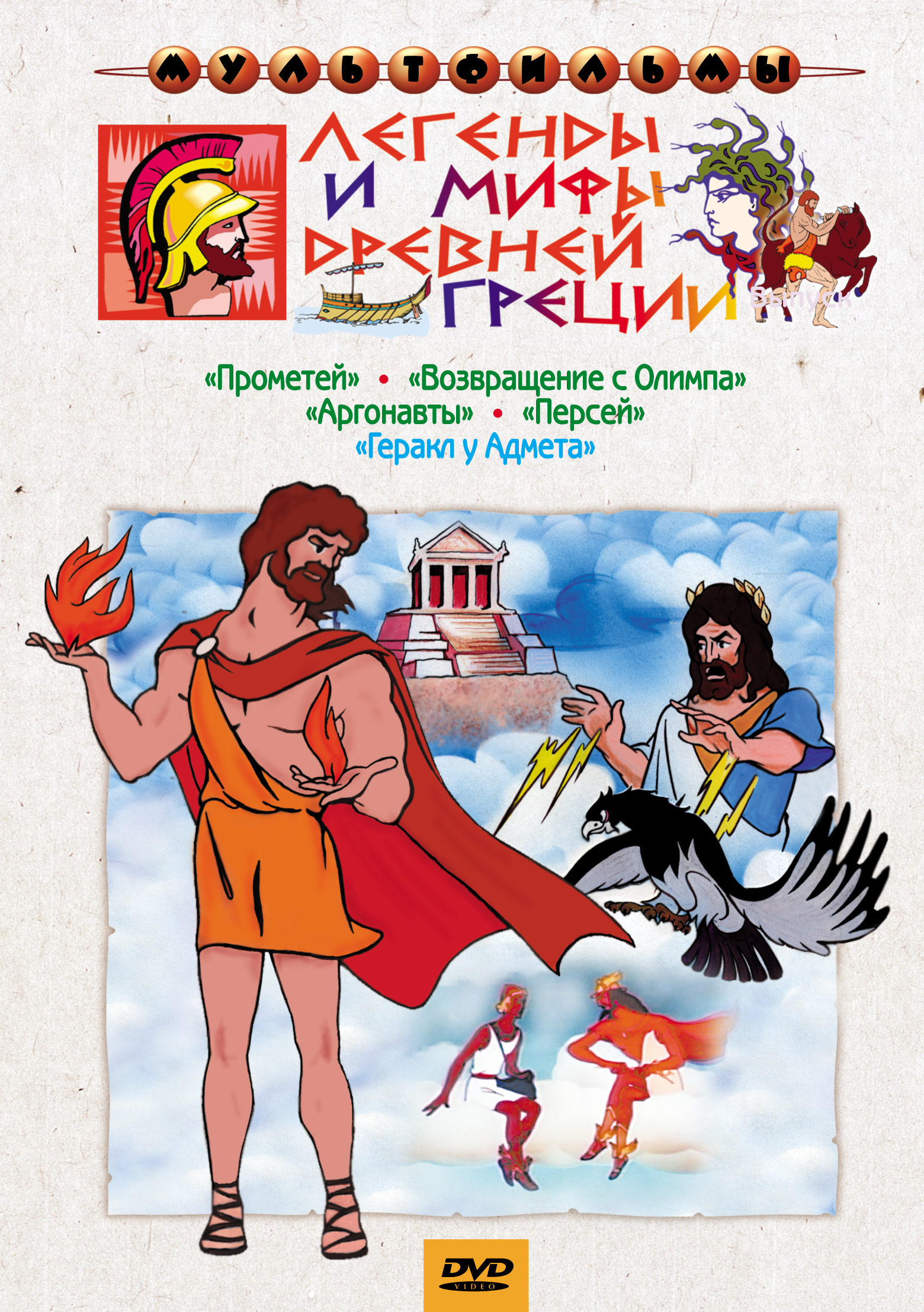Title of the work
Studio / Production Company
Country of the First Edition
Country/countries of popularity
Original Language
First Edition Date
First Edition Details
Персей [Perseus (Perseĭ)]. Directed by Aleksandra Snezhko-Blotskaia, script by Aleksei Simukov. Legends and Myths of Ancient Greece 4. Moscow: Soyuzmultfilm, 1973.
Running time
Date of the First DVD or VHS
Available Onllne
The movie is available on the “Soyuzmultfilm” youtube channel (accessed: August 17, 2018).
Genre
Animated films
Hand-drawn animation (traditional animation)*
Myths
Short films
Target Audience
Children (6+)
Cover


The covers of the entire series Legends and Myths of Ancient Greece. Courtesy of the Film Video Association “Крупный план” [Close-up (Krupnyĭ plan)] close-up.ru, accessed: August 17, 2018.
Author of the Entry:
Hanna Paulouskaya, University of Warsaw, hannapa@al.uw.edu.pl
Peer-reviewer of the Entry:
Elżbieta Olechowska, University of Warsaw, elzbieta.olechowska@gmail.com
Susan Deacy, University of Roehampton, s.deacy@roehampton.ac.uk

Aleksei Simukov
, 1904 - 1995
(Screenwriter, Scriptwriter)
Aleksei Simukov was born in St Petersburg, in a family belonging to the intelligentsia. He received classical education at the Third Classical Gymnasium (the only one in St Petersburg where Greek and Latin was taught at the time). In 1925 Aleksei Simukov moved to Moscow. He studied at the art studio of Ilya Mashkov at the Association of the Artists of Revolutionary Russia (AKhRR) and also at the Maxim Gorky Literature Institute.
He began writing plays for theatre and cinema, including animation. He preferred comical and lyrical genres, following the tradition of the 19th-century Russian theatre.
Aleksei Simukov was a lecturer at the Maxim Gorky Literature Institute. He was a literary editor of the Soyuzmultfilm studio (1944–1946), worked at the Ministry of cinematography of the USSR (1947–1950), later at the Union of Soviet Writers (1950s), and still later at the Theatre Department of the Ministry of Culture of the USSR (1964–1971) having influence on the repertory of the theaters in the country.
In his memoirs Simukov writes about scripts for the movies of Aleksandra Snezhko-Blotskaia about the Greek mythology. He says that at that time he became fascinated by myths. They inspired him to continue developing this theme and he also wrote two plays about the Greek mythology. These were Гори, гори ясно (Burn, Burn, Brightly) about Heracles and Prometheus, and Взгляд Медузы (A Glance of Medusa) about Perseus.
His life spanned pre-revolutionary and post-Soviet Russia; he finished his memoirs in 1994, a year before he died.
Source:
Simukov, Aleksei, Чертов мост, или Моя жизнь как пылинка Истории [A Devil's Bridge or My Life as a Speck of History], Moskva: Agraf, 2008.
Bio prepared by Hanna Paulouskaya, University of Warsaw, hannapa@al.uw.edu.pl

Aleksandra Snezhko-Blotskaia
, 1909 - 1980
(Director)
Aleksandra Snezhko-Blotskaia was a Russian animator and movie director.
Born in Vovchansk in Kharkiv Oblast (today in Ukraine), she later moved to Moscow oblast and Moscow. In 1925–26 she studied at the Fëdor Rerberg Art School. In 1926 she joined an art studio at the Association of the Artists of Revolutionary Russia (AKhRR). She also studied at the Architecture and Construction Institute.
From 1934 she worked at animation. First, at the Союзкинотехника ([Soviet] Union Cinema Techniques), then at the Experimental Cartoon Studio directed by Victor Fëdorovich Smirnov, at the Межрабпомфильм (Movies for Workers International Relief). She started as animator, then for a long time worked as assistant-director for Ivan Ivanov-Vano. From 1956 she worked independently and produced film adaptations of fairy tales of different nations: Verlioka (a Russian folktale, 1957), Янтарный замок ([An Amber Castle], a Lithuanian folktale, 1959), Дракон ([A Dragon], a Burmese folktale, 1960–61), Чудесный сад ([A Miraculous Garden], a Kazakh folktale, 1962), Дочь солнца ([The Sun’s Daughter], a Chukchi folktale, 1964).
She also adapted Rikki-Tikki-Tavi (1965) and The Cat that Walked by Himself (1968) by Rudyard Kipling as well as Сказка о золотом петушке ([The Tale of the Golden Cockerel], 1967) by Alexander Pushkin.
In 1969–74 she produced a series of movies about Greek mythology commissioned by the Ministry of Education of the USSR: Возвращение с Олимпа (The Return from Olympus, 1969), Лабиринт – подвиги Тесея (Labyrinth, the Deeds of Theseus, 1970–71), Argonauts (1972), Perseus (1973), Prometheus (1974). It was the most important series of animated movies about Greek mythology ever made in the USSR. The Return from Olympus was the first movie in the series Legends and Myths of Ancient Greece.
Source:
Bogdanova, Siuzanna, “Очерки и жизни и творчестве Александры Гавриловны Снежко-Блоцкой” [Essays on the Life and Work of Aleksandra Gavrilovna Snezhko-Blotskaia], Кинограф 19 (2008): 207–240.
Bio prepared by Hanna Paulouskaya, University of Warsaw, hannapa@al.uw.edu.pl
Summary
Perseus, a cheerful and kind young man, goes to kill the Gorgon Medusa. He meets Hermes, who helps him, gives him his sword and shield, and sends him to the three Graeae to get flying sandals and a magic bag. Hermes, as a god of “calculation and profit”, teaches Perseus how to take advantage of his deeds, but Perseus behaves like an altruist and a kind person. Unlike in the Ovid’s version of the myth, he does not cheat the Graeae and does not steal their eye. On the contrary, he helps the old ladies to find the eye and even offers them flowers afterwards.
Perseus fights with Medusa and kills her, looking at her reflection in the shield. Later, he sees a young woman, Andromeda, chained to a rock. He uses Medusa’s head to defeat the sea monster, and frees Andromeda, promptly falling in love with the girl. The young lovers fly high into the sky and become stars.
Analysis
This is the fourth movie in the series “Legends and Myths of Ancient Greece”. The main topic of the movie is conflict between two philosophies of the main characters: profit (represented by Hermes) and altruism (Perseus). In the movie, Perseus keeps helping others against his own interest but he is rewarded every time and prevails over evil. He is a very positive person and “believes in the force of good”. He even defends Polydectes in front of Hermes, seeing some good things in him too. Thus the movie changes the typical character of Perseus and makes it the main theme of the movie.
Another important aspect is the way women characters are presented. The main monster and enemy is the Gorgon Medusa. First, we hear about her as someone who is to be killed. Then we see her flying and killing people (changing them into stone). Commenting on this, Hermes says that Medusa views changing people into stone as giving them immortality – we see a lot of beautiful statues in the movie.
The next time we see Medusa, she is lying on a beach, sunning herself and using her wings instead of a beach towel and a parasol. She is presented as a beautiful young woman with a slim figure and nice face depicted in the Vienna Secession style. She asks Perseus to look at her, behaving like a woman who seeks a man’s attention. Only during the fight in the sky does she become her “true” self, transforming into an aggressive, angry, monstrous creature.
Other women characters are the three Graeae. They are very old ladies with one eye for the three of them. Having heard that there is a young man nearby, they start to flirt with him. Quickly they become charmed by Perseus. They behave like spinsters longing for a man’s presence.
The last female character is Andromeda, who is beautiful and young, and with whom Perseus falls in love, but she is chained to a rock. In fact, Perseus falls in love after rescuing her, so it is difficult to say what his motives were. In any case, the movie ends with Perseus and Andromeda flying into the stars like the young lovers from Marc Chagall pictures.
Perseus and Hermes are self-sufficient and independent people, but their characters are very simple and stable. Female characters are much more interesting, though we do not see active women as positive heroic figures in the movie.
Further Reading
Bogdanova, Siuzanna [Богданова, Сюзанна], “Очерки о жизни и творчестве Александры Гавриловны Снежко-Блоцкой” [Essays on the Life and Work of Aleksandra Gavrilovna Snezhko-Blotskaia (Ocherki o zhizni i tvorchestve Aleksandry Gavrilovny Snezhko-Blotskoĭ)], Kinograf 19 (2008): 207–240.
Ford, Margaret, “Persey [The Story of Perseus]”, Monthly Film Bulletin (January 1, 1976): 40.
Simukov, Aleksei [Симуков, Алексей], Чертов мост, или Моя жизнь как пылинка истории [The Devil's Bridge or My Life as a Speck of History (Chёrtov most, ili Moia zhizn' kak pylinka istorii)], Moskva: Agraf, 2008.
Profile at animator.ru (accessed: August 17, 2018).
Profile at imdb.com (accessed: August 17, 2018).
Profile at kinopoisk.ru (accessed: August 17, 2018).
Addenda
The Remaining Production Credits:
Music by Vitaly Geviksman (1924–2007); Cinematography by Boris Kotov (1922–1984); Art direction by Aleksandr Trusov (1912–1988); Sound director Boris Filchikov;
Drawings: Alla Goreva; E. Novoselskaia; M. Popova. Animators: Nikolai Fëdorov; Leonid Kaiukov; V. Kolesnikova; V. Kushnerev; R. Mirenkova; Viktor Shevkov; E. Vershinina; V. Zarubin.
Date of the First VHS and DVD Edition:
According to Wikipedia, the movie was released in the 1980s on VHS in the series “Видеопрограмма Госкино СССР” (Video program of the State Committee for Cinematography of the USSR). I was unable to verify this information.
The movie was released on DVD in 2005 by Film Video Association “Крупный план” [Close-up (Krupnyĭ plan)] in a collection of movies called Легенды и мифы Древней Греции [Legends and Myths of Ancient Greece (Legendy i mify Drevneĭ Gretsii)]. The DVD also contained the movies Прометей [Prometheus(Prometeĭ)], Возвращение с Олимпа [Return from Olympus (Vozvrashcheniie s Olimpa)], and Аргонавты [The Argonauts (Argonavty)] by Aleksandra Snezhko-Blotskaia and Геракл у Адмета [Hercules at the Court of Admetus (Gerakl u Admeta)] by Anatoly Petrov.
It is also part of a collection of movies called Аргонавты [The Argonauts] (Фильмы А. Снежко-Блоцкой, вып. 3 [Movies by A. Snezhko-Blotskaia, Disc 3]) released by the same company in 2009. The DVD also contained the movies Лабиринт. Подвиги Тесея [Labyrinth. The Deeds of Theseus], Прометей [Prometheus].
It is also part of a collection of movies called Аргонавты. Фильмы А. Снежко-Блоцкой, вып. 3 [The Argonauts. Movies by A. Snezhko-Blotskaia, Disc 3 (Argonavty. Filmy A. Snezhko-Blotskoĭ, vyp. 3)] released by the same company in 2009. The DVD also contained the movies Аргонавты [The Argonauts (Argonavty)], Лабиринт. Подвиги Тесея [Labyrinth. The Deeds of Theseus (Labirint. Podvigi Teseia)], Прометей [Prometheus (Prometeĭ)].
There were other releases of the DVD after 2009.
All links accessed: August 17, 2018.


